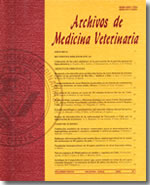Transfection of salmon cellular line CHSE-214 using a non-commercial liposome
Main Article Content
Abstract
The fast growth of Chilean aquaculture has impelled the exploration of new strategies of sanitary prevention. DNA vaccines appear as a feasible alternative for disease control, however there are technical barriers such as the form of administration and the carrier systems which need to be resolved. Liposomes are widely used for gene delivery in mammalian cell lines, but their high cost makes difficult their use at an industrial scale. Considering this economic problem and in order to contribute with an in vitro procedure for transfection of salmon cells, the objectives of this work were to formulate a liposome from DOTAP lyophilized powder and to develop a transfection protocol using eukaryotic vectors for the fish cell line CHSE-214. The liposome properties and the optimal transfection conditions were established using pcDNA 4.0 HisMax I TOPO and pIRES-EGFP vectors and Chinook CHSE-214 cell line (ATCC 1681). The results indicated that the liposome formulated from DOTAP lyophilized powder shares all the characteristics with the commercial liposomes and has a lower cost, approximately 10 times less. By using this liposome, it was possible to develop a transfection protocol for CHSE-214 fish cells with eukaryotic vectors without toxicity signs which allowed the expression, in both vectors, of the incorporated gene.

